Technical specifications
The SS-650KM3 (X-650) and SS-850KM3 (X-850)
are the same as their predecessors in the specifications and meet the
requirements of these present days by being able to provide most of their power
output through the voltage range +12 V. The load capacity of the less important
+5 V and +3.3 V voltage range is quite low at 125 watts.
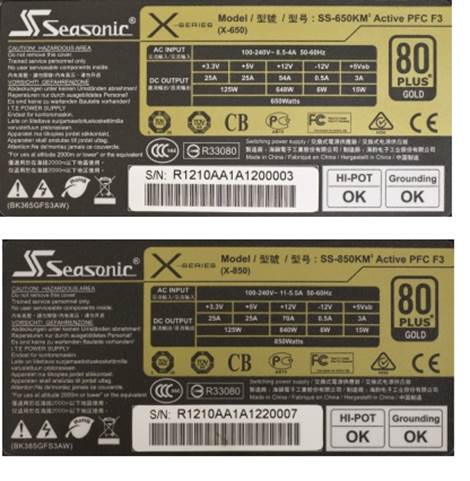
Technical
specifications
These PSU sources that are similar to their
predecessors accompany with 80 PLUS Gold specifications. The warranty period
has been lasted from five to seven years, so the SS-650KM3 (X-650) and
SS-850KM3 (X-850) are able to be on par with Seasonic’s Platinum-certified
products in this aspect.
Generally, the cable system has become more
balanced and updated compared with the sources’ predecessors.
The summary of the Seasonic SS-650KM3
(X-650) technical specifications:
·
Intel Specifications: ATX12V/EPS12V
·
Dimensions: L160 x W150 x H86 mm
·
Performance: 80 Plus Gold / Energy Star / ErP
Lot 6 2013 compliant
·
Protection features: OPP / OVP / UVP / OCT / SCP
/ OTP
·
Hazardous materials: WEEE / RoHS
·
AC Input Range: 100-240V ~ 50-60Hz 8.5-4A
·
Connectors: M/B 24/20 Pin Connector x 1 (610 mm);
CPU 8/4 Pin x 1 (650 mm); CPU 8 Pin x 1 (650mm); PCI-E 8/6 Pin x 4; Peripheral
4 Pin x 5; SATA x 10; Floppy x 1 (Y-adapter)
·
Voltage parameters: Combined power (+3.3V), W:
125; Combined power (+12V), W: 648; Combined power (+5V), W: 125; Combined
power (-12V), W: 6; Combined power (+5Vsb), W: 15; Max output current (+3.3V),
A: 25; Max output current (+5V), A: 25; Max output current (-12V), A: 0.5; Max
output current (+5Vsb), A: 3; Max output current (+12V), A: 54
UPS
compatibility
Operating together with our APC SmartUPS SC
620, the X-650 was stable at loads up to 412 watts when running by the power
source but only likely to switch to the UPS’s batteries at loads up to 302
watts. The corresponding numbers for the X-850 are 403 and 300 watts.
The voltage stability
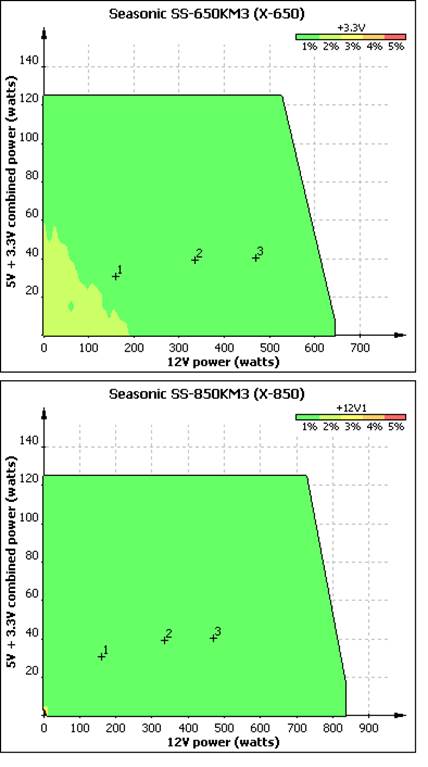
Voltage
fluctuation
It is impossible to find fault with the
stability at all levels of these PSU loads. The +12 V voltage range is always
required within 1%, while the other voltage ranges are within 2%.
Thus, the newest Gold-certified PSUs from
Seasonic in this test are better than their predecessors, the products might
not always keep their voltage ranges within the 3% as promised by the
manufacturer.
Output voltage ripples
The latest PSUs from Seasonic were superior
to the previous products in the previous test, but that was not evident here.
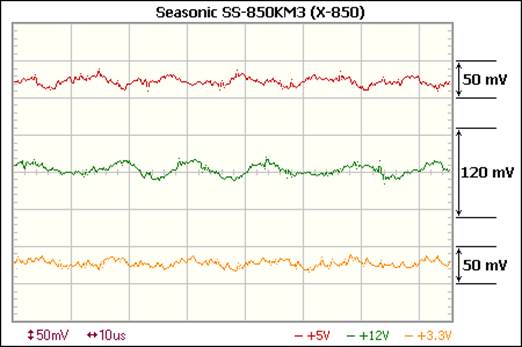
The
graph describes the output voltage ripples.
The high-frequency voltage ripple is within
the allowable limits, but more powerful than with the previous sources of this
product series. In this way, the SS-650KM3 (X-650) and SS-850KM3 (X-850) also
reach the same results here; so we only show you the graph of a higher capacity
model.

The
graph describes the output voltage ripples.
The output voltage ripple at the dual
frequency is a little weaker than with the X-650
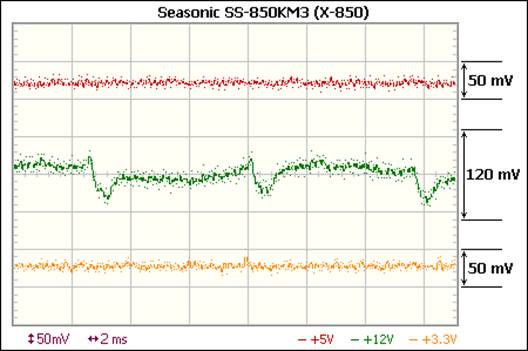
The
graph describes the output voltage ripples
The low-frequency voltage ripples of the
X-850 are weak on the +3.3 V and +5 V voltage ranges, but strong on the +12 V
voltage range. Even so, it is always within the standard.
Temperature and noise
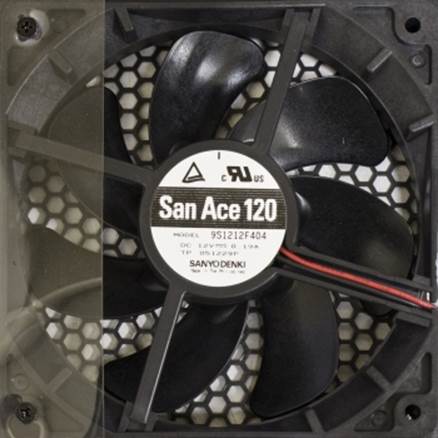
PSU’s
fan
As Seasonic’s Gold-certified PSUs earlier,
the SS-650KM3 (X-650) and SS-850KM3 (X-850) employs a Sanyo’s Denki San Ace 120
fan (the model number: 9S1212F404, the highest preset speed: 2,200 RPM). Such
fans are perfectly designed and balanced to minimize their operating noise.
The new PSUs have a switch to select the
fan’s operating mode between Normal and Hybrid modes. In the Normal mode, the
fan always operates, starting up at low speed and then accelerating at higher
loads. In the Hybrid mode, the fan works at an idle status at low loads and only
works continuously at high loads.

The
graph describes the levels of noise and temperature
Therefore, in the Normal mode, the X-650’s
fan boots up with a speed of 830 RPM and begin accelerating at a load of 550
watts only. The accelerating process is fast, giving more than 400 RPM for the
fan speed over a load range of 100 watts, but the results even at 1,300 RPM
speed also did not produce annoying sound thanks to the fan’s high quality.

The
graph of temperature and fan speed factors
In the Hybrid mode, the fan is idle until a
load of 400 watts and then starts to switch on occasionally. It is only above
500 watt loads that it runs constantly. Its maximum speed is similar to the 1,300
RPM as in the Normal mode.
The X-850 is expected to generate the sound
that is noisier at high loads because of its higher wattage.

The
graph of temperature and fan speed factors
In the Normal mode, the initial speed of
the fan is a little lower than the 650W models’ and the fan speeds up at a
slightly higher load. Anyway, the X-850 is also pretty noisier than its
relatives, when at full load, its fan revolves at 1,700 RPM (which is compared
to the results of the products form its predecessors, in the same way).

The
graph of temperature and fan speed factors
For the Hybrid mode, the X-850 works the
same as the X-650. The fan speeds up earlier than in the Normal mode, but not
too fast, eventually reaching the same maximum speed.
The two PSUs work very quietly at medium
loads (even is completely silent in the Hybrid mode). Only at high loads (above
600 watts) the fans make you feel their presence, but we suspect that the PSUs
will be the computer’s main source of noise then.
Efficiency and power factors
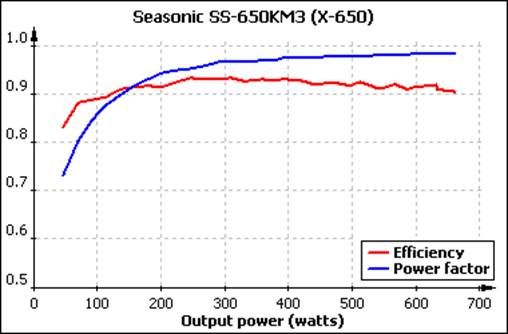
The
graph of efficiency and power factors
At the reference loads of 20%, 50% and
100%, the X-650 reached 90.6%, 92.9% and 90.5% efficiency. Its highest
efficiency was 93.4%, which was observed at a load of 311 watts. We are also
able to realize that its efficiency was higher than 90% at any load levels
above 120 watts.
The power factor is only slightly lower
than the promised level of 99% at high loads.
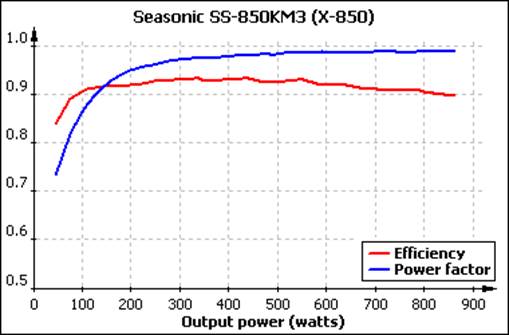
The
graph of efficiency and power factors
At the reference loads of 20%, 50% and 100%
the X-850 reached 91.8%, 93.3% and 89.8% efficiency. The highest efficiency
that was 93.5% was observed at 435 watt loads. We are able to see that its
efficiency was higher than 90% in a load range of 100 to 830 watts.
The power factor was 99% at high loads.
In general, these PSUs reach a bit more
efficiency than their previous products.
Standby source
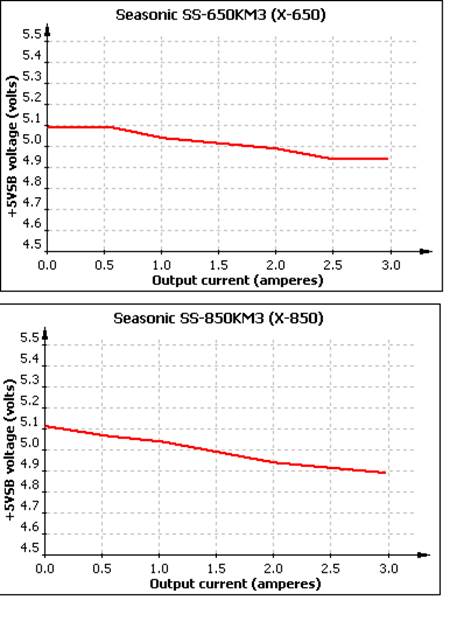
Standby
source